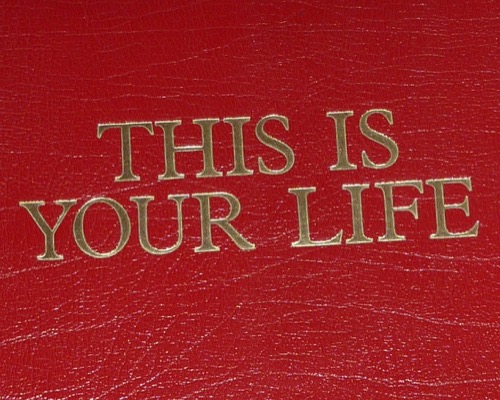Big Red Book
Celebrating television's This Is Your Life
23 September 2004

a brief biography
the programme's icon
those who said 'No'
the genesis of the programme
OVER the next year or so the name of Eamonn Andrews OBE will once again spring onto the TV screens of Ireland and England.
And all to mark the 50th anniversary of the launch of This Is Your Life, a programme that became linked in so many ways with the name of Andrews, the gentleman of television, from Portmarnock.
It is now 17 years since his death at the age of just 64. He had appeared ill for some months before, but his death in November 1987 sparked incredible grief throughout the television industry.
And in Fingal and Portmarnock, they mourned the great man. His funeral in Portmarnock church was one of the biggest ever, wreaths flooded in from household names who called him friend, Wogan, McCartney, Monkhouse and the rest.
People still recall the big man (he was 6'1") and at that time the biggest star on British TV, stepping forward to do the readings at Mass on Sundays, while his son Fergal was an altar boy.
Oft times he could be spotted walking or jogging on the beach or playing a round of golf - a true community man.
He lived at an area called 'The Quarry' - a glorious home, inspired by architect Sam Stephenson, that included a swimming pool and ample room for the presenter to relax at the end of a hard week.
Andrews and his wife Grainne (Bourke) did live in London for many years as Eamonn's career blossomed but it was around 1970 that they decided Fingal should become home.
They wanted their kids to grow up in Ireland and decided that was the best move, all round, for the family.
Then commenced the long London commute for Andrews.
Being so dedicated to the This Is Your Life programme, he spent hours upon hours checking all the facts and details for each show.
He left his Portmarnock home on a Monday morning for the airport and spent the week there, before returning for the weekend.
But how did a genial, but yet shy youth, come to be the most famous man and one of the best paid presenters in Britain?
He began life as a boxing commentator with RTE - actually boxing in an Irish final one night at the stadium and then jumping out of the ring to describe the next bout!
He went on to present 'Question Time' for RTE, the first show actually going out live in Rush.
He pushed himself to be the best and always wanted a shot at British TV. In 1950, he got his break with 'Ignorance is Bliss' on BBC radio.
'What's My Line' was to launch him big time into the limelight, working alongside the famed Gilbert Harding.
At one stage he was offered a deal in the United States but turned it down.
In 1955, an idea that had been spotted in America was transformed for the British audience, This Is Your Life was born.
Eamonn was regarded as the man to do the compere job and within seven years it had moved from a monthly slot to a weekly one.
Andrews, at times, must have lived on his nerves. If the required person didn't turn up or refused to accept the big red book - the show was over.
Danny Blanchflower was one of the most famous to walk away when Eamonn called in 1961.
Andrews, indeed, was deemed so famous he was actually the first person to be caught out with the famous book, after the name of the initial choice, Stanley Matthews, ended up in the newspapers the day before the show launched.
Crackerjack was another show he was asked to compere, even managing to get the Queen to appear on it.
He moved from the BBC to ITV in 1964 after the BBC dropped This Is Your Life, feeling it had run its course. ITV gave him his own programme, the first TV chat show.
But Andrews was back at the helm of the This Is Your Life show in 1969 when Des O'Connor was surprised.
Outside of TV, Eamonn had business connections in Ireland including the Gaiety Theatre which his company ran and a floating nite club on the Liffey called the MV Arran in the mid 80s.
But when both businesses failed, he took the disappointment hard.
Andrews was associated with many other programmes in Britain, simply because of his manner and the fact that people knew he would not let them down.
By the early 80s, up to 20 million people watched him every Wednesday at 7pm at a time when he was bigger than Hughie Green and Opportunity Knocks, David Frost and Michael Parkinson.
But the workload began to create cracks in the big man's health but he was one of the those people that believed in all or nothing when it came to professionalism.
In November, 1987 he was admitted to hospital and died in his sleep.
If one needed proof of his popularity it came at the special memorial mass held in Westminster Cathedral shortly after his death.
Henry Cooper carried the gifts, Cardinal Hume and 25 priests concelebrated the mass and hundreds of stars turned out.